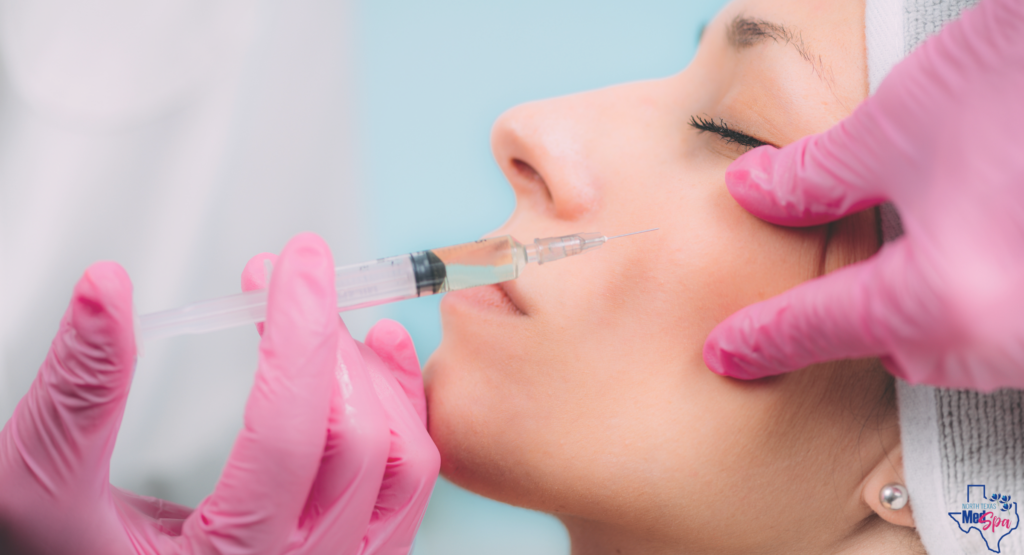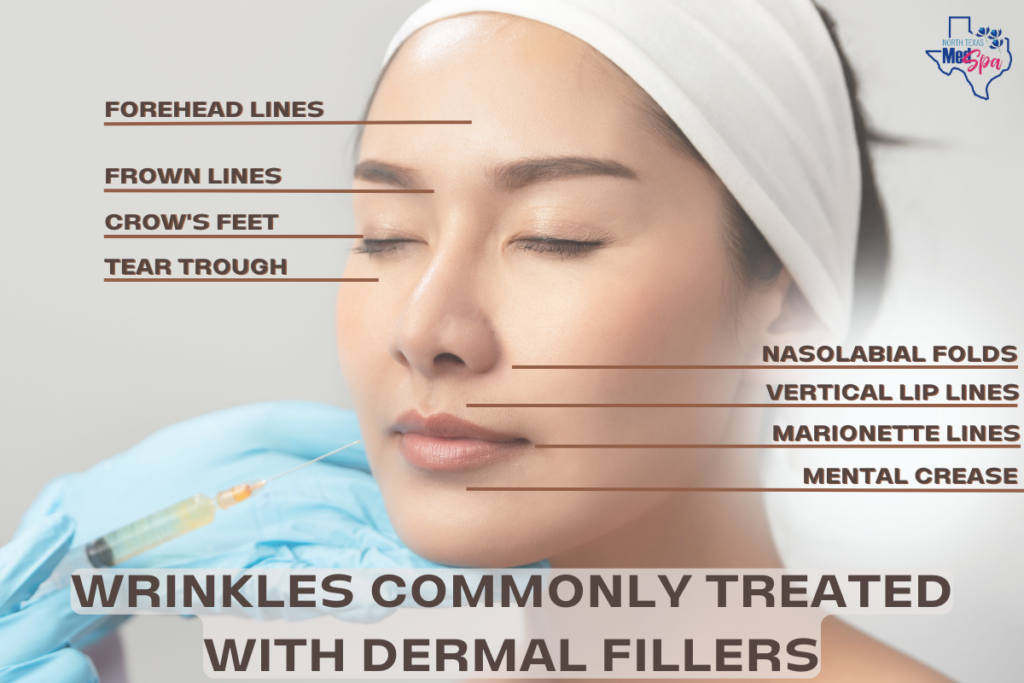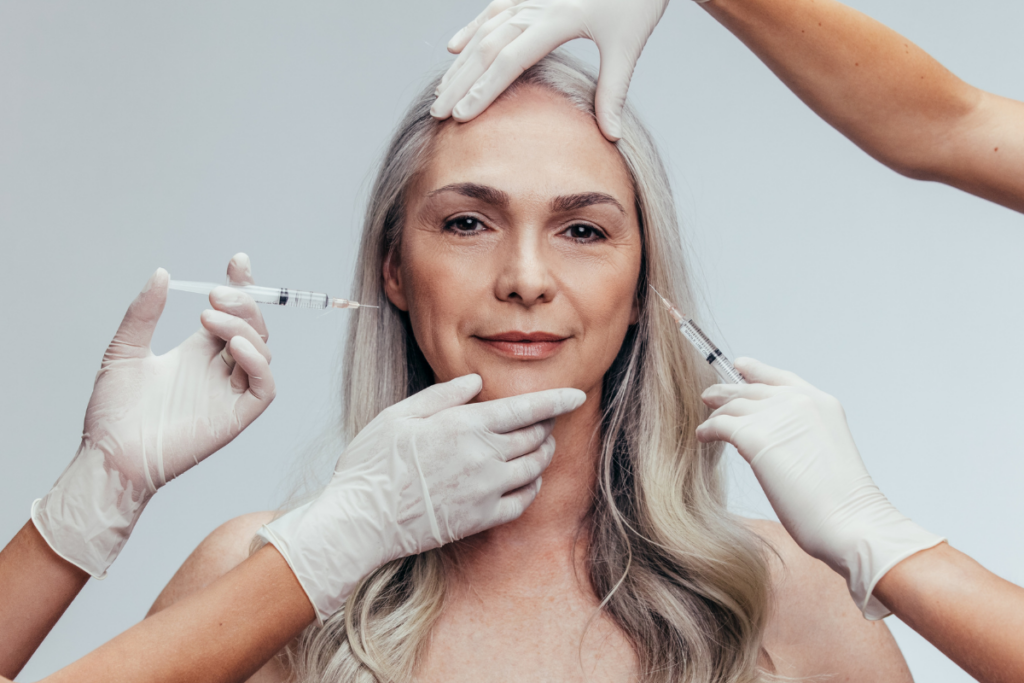
If you’re like many people, you are concerned about looking older. Fortunately, different types of dermal fillers can help you look younger and feel more confident in your skin.
For many years, the only way to erase those pesky signs of aging was to get costly and painful plastic surgery. Now, we can turn back time on your skin with nothing more than a few injections.
However, with the recent headlines about celebrities dissolving fillers and wanting to look more natural, you might wonder how the different types of dermal fillers work. Or, more importantly, you want to ensure you don’t look plastic or unlike yourself.
We want that too!
So, let’s look at the types of fillers, how we use them, and how you can feel confident you’ll be happy with your results.
What Are Dermal Fillers?
Dermal fillers are cosmetic treatments that restore volume, smooth wrinkles and uneven skin surfaces, and enhance facial contours.
These minimally invasive injectables can improve or solve some of your biggest aging concerns. They can:
- Diminish or erase wrinkles, lines, and folds
- Fill hollow cheeks and droopiness under your eyes
- Improve the appearance of scars
- Increase the volume of your lips
- Add contours to your face, such as along your jawline
Because everybody’s face and desires are unique, there are different types of dermal fillers to solve various problems.

Different Types of Dermal Fillers
There are several types of dermal fillers available, each designed to address specific concerns and areas of the face.
While we don’t carry each filler type at our location, it may be helpful to know about them if you have needs we can’t solve.
Hyaluronic Acid (HA) Fillers
Given its popularity in skincare products, you might already be familiar with hyaluronic acid. If not, it’s a substance our bodies produce to help keep our tissues hydrated and flexible and our joints lubricated.
As we age, we start producing less hyaluronic acid, which, among other things, can make our skin dryer, more wrinkled, and less youthful. Replacing hyaluronic acid with fillers improves these issues.
The best things about HA fillers are how versatile they are to use in different parts of the face and how natural they look. Plus, increased hyaluronic acid promotes more collagen production, enhancing these dermal fillers’ benefits.
Since HA is a naturally occurring substance in the body, it doesn’t have the longest-lasting effects due to reabsorption. Depending on the type and your body’s reaction to them, HA fillers can last up to 18 months or as little as three months. However, this can be a pro as much as a con because it allows you to try different things to achieve the look you want.
It’s also the only filler that can be dissolved if you’re unhappy with the results. All others have to break down on their own or be surgically removed.
Because of their versatility and benefits, almost all the types of dermal fillers we use are hyaluronic acid fillers. For first-timers, we believe it’s usually the best choice. Plus, different HA fillers provide unique benefits that address a wide range of issues.
Types of HA Fillers at our MedSpa
Juvederm Ultra XC and Ultra Plus XC — These two types of Juvederm fillers are hydrophilic, meaning the size of the HA strands and how they connect attract water. This creates a more volumizing effect, making them perfect for your lips, cheeks, and marionette lines.
Juvederm Voluma — This hyaluronic filler has tighter links between the strands, so it doesn’t attract as much water as the Ultras. This keeps the HA gel from dissolving as quickly, which typically leads to longer-lasting results. It’s also firmer, making it more beneficial for adding contour to your chin, jaw, and cheekbones.
Belotero Balance — Belotero is less dense than Juvederm, allowing more water absorption. This creates a more flexible and natural-feeling effect that works well on medium to deep lines around your nose (nasolabial folds), mouth, and chin. But it’s also delicate and soft enough to improve lines around your tear trough and above your lips.
Restylane Kysse — This unique lip filler is made with XpresHAn Technology™, which refers to the crosslinking of HA strands. It’s very flexible and natural-looking and many people say that it enhances your lips’ color more than other options. However, it is only approved for use on the lips.
Revanesse Versa — The thickest HA filler we offer is Revanesse Versa. This one is densely linked and produces long-lasting results. We think it’s a terrific choice for improving nasolabial folds, marionette lines, mental creases, and tear troughs. Because of the shape and linking of the HA strands, this one also produces less swelling than other HA fillers.

Calcium Hydroxylapatite (CaHA) Fillers
The only other type of filler we use at North Texas MedSpa is Radiesse, a Calcium Hydroxylapatite (CaHA) filler.
Like hyaluronic acid, CaHA is a naturally occurring substance in our bones. In dermal fillers, these microscopic calcium particles are suspended in a gel.
CaHA fillers are significantly thicker than HA fillers. Not only does this often last longer, but it is a better option for deeper, more pronounced lines and wrinkles and restoring volume to your cheeks.
This type of dermal filler also stimulates more collagen and elastic production than HA fillers, making the results last even longer.
The downside is that CaHA fillers cannot be dissolved. Be sure to discuss your goals and the pros and cons of this filler with your technician before treatment.
Poly-L-lactic Acid (PLLA) Fillers
Unlike HA and CaHA fillers, Poly-L-lactic Acid fillers work differently. The most common brand is Sculptra.
This injectable doesn’t provide immediately dramatic results. Instead, it stimulates your skin to produce more collagen over time, restoring youthful facial volume.
PLLA fillers can last up to two years and are perfect for restoring volume to noticeably sagging areas of your face. You can even use these on other body parts, such as your thighs and chest. However, it’s not an appropriate choice for delicate areas, like lips and eyes.
Polymethylmethacrylate (PMMA) Fillers
Polymethylmethacrylate (PMMA) fillers are similar to PLLA fillers in that they promote collagen production. However, this filler provides semi-permanent results that can last up to 5 years.
PMMA fillers contain a combination of tiny spheres of polymethylmethacrylate, a biodegradable material, suspended in a collagen gel. These spheres add support to deep folds, significant wrinkles, and pitted scars. They also provide a solid structure to existing collagen fibers as your body makes more collagen.
The most well-known PMMA filler is Bellafill, and it is most commonly used for deep nasolabial folds and significant acne scars.
Aside from the dramatic results, the best benefit is how long it lasts. That said, if it doesn’t look the way you want, the only way to remove PMMA fillers is surgically. So, you should discuss your goals and concerns with a licensed injector before treatment.
Autologous Fat Injections
The last type of dermal filler is autologous fat injections, also known as lipofilling.
This procedure involves performing Liposuction from one area of your body (usually your abdomen or thighs), purifying the removed fat, and injecting it into the desired area.
Some well-known fat transfer procedures are the Brazilian Butt Lift and breast augmentation. But it can also be used for plumping lips, sunken cheeks or under-eye areas, and folds and wrinkles in your face.
Lipofilling should only be performed by a licensed plastic surgeon. One procedure may be enough to achieve the look you want, but sometimes your body reabsorbs the fat, requiring additional procedures.
While there’s little risk of allergic reactions, other complications can occur if you don’t follow your doctor’s aftercare instructions closely. The other drawback to fat injections is the amount of healing time. Your body has to recreate blood sources to the transferred fat before you have a complete picture of how it will look.

Which Filler is Right for You?
Choosing the right filler depends on several factors, including the area you’d like treated, your desired results, and your overall health and skin condition. A thorough consultation with a qualified aesthetic healthcare provider can help determine the best approach for your needs.
Our goal is to make sure you’re happy with what you see in the mirror, so giving us as much detail as possible can help you achieve your desired look.
Bring a picture if you see a celebrity with results you’d like to emulate; a visual reference can be hugely helpful. Or, if you know somebody who received fillers and like how they look, ask them what kind they got. Your results may not be exactly the same, but it provides a good starting point for what you want.
Patience is key. Most injections involve a small amount of swelling for the first 24 hours. This can be jarring on your first time because the injected area may be plumper than you’d like. But it’s temporary and will go down.
It’s also vital that you follow your aesthetician’s recommendations both before and after your procedure. These can help prevent complications and provide better, longer-lasting results.
Finally, with all the types of dermal fillers, it is absolutely crucial that you only receive them from licensed professionals. While it is a safe procedure, you’re still having someone inject substances into your body. And if done incorrectly, it can have undesirable and even life-threatening outcomes.

Different Types of Fillers for Your Unique Needs
Dermal fillers are a fantastic choice to enhance your appearance and address common signs of aging. They can improve everything from shallow wrinkles to deep acne scars.
By understanding the different types of fillers and their uses, you can have a more informed discussion with your technician to ensure you’ll be happy with your results.
Remember, while dermal fillers can work wonders, the skill of the injector is equally, if not more, important to achieve your goals.
No matter what you choose, taking the first step towards rejuvenating your appearance can significantly boost your confidence and help you look your best.

